Playing in a new reed:
For a clarinettist to find that perfect reed which plays exactly how he wants it to sound and plays the music just as he has in his imagination is not a myth and shouldn't remain a dream. It's just a question of careful preparation.Generally you start off by choosing a few favourite clarinet reeds out of the new box. Once you have a selection of five to ten reeds you can begin to work.
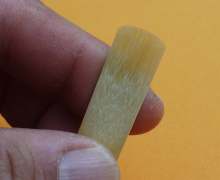 A careful maintenance of your clarinet reed starts with a well timed break in process. You should never play in a new reed
for more than five to ten minutes. Once you can see that the tip of the reed has absorbed moisture you should give it
a chance to calm down and to breathe dry air. If you change it, the fibres can close their ends and the cane will
keep its flexible qualities for a longer time.
A careful maintenance of your clarinet reed starts with a well timed break in process. You should never play in a new reed
for more than five to ten minutes. Once you can see that the tip of the reed has absorbed moisture you should give it
a chance to calm down and to breathe dry air. If you change it, the fibres can close their ends and the cane will
keep its flexible qualities for a longer time.
Every single reed is a unique personality with strengths and weaknesses, rough edges and moods of its own, just depending on density and length of its fibres and on current weather conditions as well. After three to four days of blowing, clarinet reeds usually have already undergone the first changes. The cane fibres do not suck as much water as they did at the beginning, but response and sound will certainly have changed. It may be that you are somehow dissatisfied with a reed and have discovered one or two whims in it. Maybe this is also the time when you have to leave one or the other friend among your favourite reeds, e.g. if it turns out that a reed is not that elastic as considered at the beginning. If the tip of the reed can be bent in such a way that it no longer returns to its original shape, then any love effort will be in vain. For promising specimens it may now be time to edit these reeds or at least make the first important correction: With a flat smoothed groundsurface everything else is easier.
Only if your clarinet reeds have been played for a few more days and the bottom surface is still beautifully flat it is worth storing them in a reed case. There they are stored safely and protected and they are ready for use anytime and anywhere. After a few more days, the two or three best reeds will usually stand out from the small Favorites series. If they are carefully cared for, they usually become loyal friends and reliable companions of a clarinettist in concert for a long time. Even some old comrades, who have several months, sometimes up to one year on their backs, can be briefly revived with a glass of mineral water and a soft cotton cloth. The carbonic acid dissolves the mostly calcareous whitish coating and will open the closed pores a little bit. A few strokes with the moistened cloth, starting from the heel towards the tip of the reed and beyond, clean the surface additionally and thus support this effect. A reed that can no longer absorb any water usually sounds overly shrill sharp or piercing, and once the gentle warm and smooth sound curves did say "good bye", then unfortunately your beloved reed's lifetime has reached the end.
Are you already supplied? You can ask questions or
send your Order clarinet reeds now!
Adjusting clarinet reeds, recommended alterations and remedies step-by-step:
Clarinet reeds are made of cane, which is a natural material. As such, it is constantly changing according to air pressure or atmospheric humidity. Professional soloists and orchestral clarinettists have observed from experience that reeds are stronger at high altitude than at sea level. They also lose their strength in warm, humid air compared to in cold and dry climates.Apart from occasionally reflecting to adjust your clarinet reed according to your personal preferences you may consider remedies due to an uncomfortable playing condition of your reed. Especially while playing in new reeds, some advice for a quick help is very much appreciated. With only reasonable effort and a little practise and instruction every clarinettist, who is interested in material questions, should be skilled enough to successfully help himself.
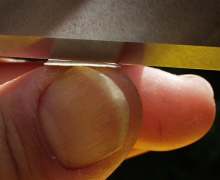 Changes in climate usually have the following effects:
Changes in climate usually have the following effects:
The bottom side of the reed swells at right angles to the grain. This makes the reed speak less easily and makes it more difficult to control flexibility in timbre and dynamics.
Smoothing the bottom side of a clarinet reed
is a fundamental requirement in order to fully assess which will be the next step in your reed adjusting process. So this should be our first step. Bend the tip of the reed back a little bit on a flat surface (opposite to the face of the mouthpiece).If there are any swellings at the bottom, correct them by smoothing them on a grindstone. (Available from us at foglietta).
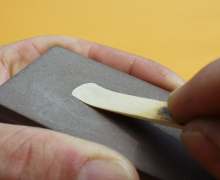
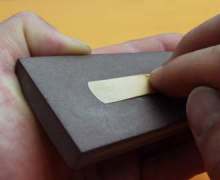
If your reed sticks up
or it seems to be too stiff, place your three fingers a little more towards the shaped bit, whilst smoothing the reed. In case yourclarinet reed tends to lie too close on the mouthpiece
or tends to lack tension, try to hold it more towards the end of the bottom during this procedure. You may also use a sheet of abrasive paper (grain size 280 or 400) put on a level glass plate. In this case your reed needs to be totally dry and the reed tip must not be wavy!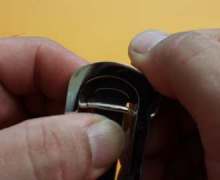
Clarinet reeds occasionally might squeak when playing staccato:
Push the reed tip a tiny fraction of a millimeter beyond the tip of your mouthpiece. Try to find a balance between ease of playing and a reed getting too hard. If you achieved an improvement by doing this do not hesitate to take a reed trimmer (have a look at our accessories) and shorten the reed tip by cutting the required amount. By doing this the tip of the reed gains more stability from its central part, but be careful, the reed becomes harder and stiffer if you cut too much off.When reeds do not respond easily or the sound is fuzzy
perhaps you need to check the tip. From changes in humidity or from normal use, reed tips tend to get thicker and stiffer. The air can no longer stream properly along the surface when playing and this may cause a worse response or a fuzzy noise accompanying your pianissimo. Such a reed produces a noisy chattering sound while playing forte and it keeps you from varying your dynamics flexibly.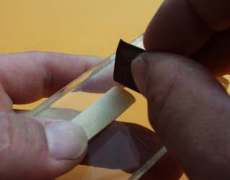 To solve this, use a small pie of sandpaper (grain size 400) wrapped around your fingertip, and sharpen
the top one or two millimetres of the reed. Place the reed on a flat glass surface and move your finger five or
ten times from the glass onto the tip using a small circular motion and without pressing too much. Be careful
not to let the sandpaper get between the fibres or to slit the tip of the reed as this would completely ruin it.
After sanding about 5 to 10 times, your reed should speak much more easily.
To solve this, use a small pie of sandpaper (grain size 400) wrapped around your fingertip, and sharpen
the top one or two millimetres of the reed. Place the reed on a flat glass surface and move your finger five or
ten times from the glass onto the tip using a small circular motion and without pressing too much. Be careful
not to let the sandpaper get between the fibres or to slit the tip of the reed as this would completely ruin it.
After sanding about 5 to 10 times, your reed should speak much more easily.
Reeds that vibrate one-sidedly
may be made of a piece of cane grown with an unequal density of fibres at one side of the reed compared to the other. This can be easily controlled - a stable embouchure is a pre-requisit - by turning the instrument once to the right and once to the left alternately. Turning your clarinet a little bit to the right means you try the left side of your reed and vice versa. The side that is harder to play is too dense and you will have to take out some cane.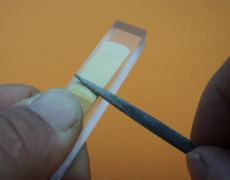
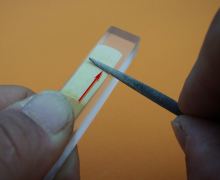
By doing this on both sides of the reed you can also cure an
unpleasant vibrating of the lower notes
in each register (such as low e, f as well as b and c in the upper register). Please always keep in mind that stability which has been taken out of the reed can never be put back again, so you should preferably play your reed twice rather than using the file once too often!Making a clarinet reed softer :
With a new reed which is too strong or which needs to much mimical muscle power to play, you can help yourself with a trick. Let your reedtip take some water then turn the reed upside down and carefully bend the tip on your grindstone a little bit towards its bottom surface or a bit towards your mouthpiece facing.If, after all that playing-in and after all your corrections made so far, it should nevertheless happen that one of your reeds has too much tension, or is too stiff, then - and only then - you may start to carefully sand the entire back a little thinner starting from the heel. Use a piece of fine sandpaper for this. Working a bit more precisely will be easier by using a piece of winter-horsetail or a needle file together with a processing support for the reed.
During this correction please do not exceed the rear third of the reed tongue by the fro and back of your movings and make sure that you are working symmetrically to both sides. Also here, the following applies: Please always take care that you are working carefully from outside towards the middle and from the heel towards the tip. Please do not forget to blow the reeds again and again before you are going too far with a correction. If you once have taken out to much cane towards the heart, the reed will quickly lose its stability and begins to clatter. It would be a pitty for a reed with great possibilities!
By following these steps your clarinet reed
will have a long and happy life.
